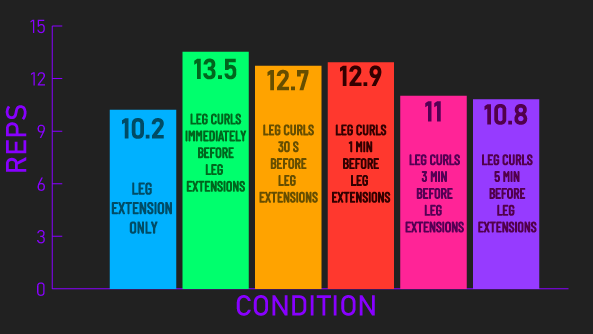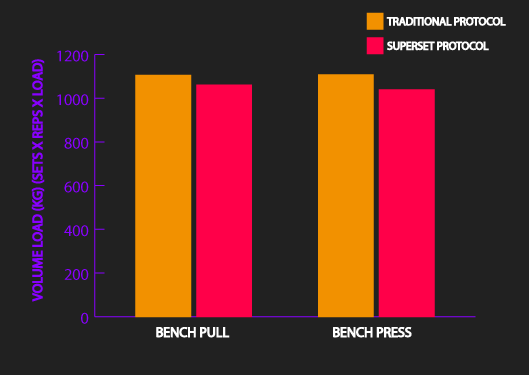
In this article, we’re examining antagonist supersets, which have you perform two exercises that train opposing muscle groups back to back. We’ll also touch on antagonist stretching too.
Examples of antagonist supersets include:
- The barbell row and bench press
- The overhead press and pull up
- the leg curl and leg extension
- a biceps exercise with a triceps exericse
Let’s dive straight into the literature.
Table of Contents
Part I: Better Performance With Antagonist Supersets
There’s reliable literature indicating antagonist supersets do not compromise performance. In fact, it has the potential to increase your work capacity.
A 2014 study out of Brazil compared performing leg extensions only to performing leg curls before leg extensions.
Performing the leg curls before the leg extensions increased the number of reps performed on the leg extension.
They also found the shorter rest between the two exercises, the better the leg extension rep performance.

Specifically, performing the leg extensions immediately after the leg curls outperformed using a 30-second, 1-minute, 3-minute, and 5-minute rest between the two exercises.
For clarity, subjects of course performed repetitions to failure on the exercises, and a 10 rep max load was used on the exercises.
Other experiments support these findings.
A 2015 study out of Brazil compared performing 3 sets of bench presses and then 3 sets of seated rows traditionally to super setting the two exercises with virtually no rest between them.
Volume load on both exercises was greater for the superset condition.

Volume load is calculated by multiplying sets, reps, and load. Given both groups performed 3 sets and used 10-rep max loads, the greater volume load for the supersets would be explained by them being able to perform more repetitions.
It’s also worth noting the superset session was, of course, shorter in duration (8.5 mins vs 16 mins).
3 other studies (one, two, and three) demonstrate antagonist supersets increase performance versus normal sets. All these studies also had subjects superset the two exercises with minimal rest between them.
As per the first study assessed, minimal rest is likely the best for increasing performance. Resting long between the two exercises may not produce performance gains.
A 2010 study from Australia further supports this.
A superset condition performed 3 supersets of bench pulls with bench presses, but used 2 minutes of rest between the supersets, resulting in 4 minutes of rest between the identical exercises.
A traditional condition performed 3 sets on the bench pull followed by 3 bench press sets, with 4 minutes of rest between sets.
Both groups performed reps to failure with a 4 rep-max load on the exercises.
Overall, volume load was not statistically different between the conditions.

Now, though this superset protocol didn’t increase performance, it still was quicker to complete than the traditional protocol (10 mins vs 20 mins).
So if an individual doesn’t want to perform antagonist supersets with minimal rest between the two exercises, having some rest between the two movements can still be effective for saving time.
So making things crystal clear, antagonist supersets do not compromise performance.
Rather, using minimal rest between the two exercises actually seems to increase your rep performance. Resting longer between the two exercises does not seem to do this, but it’s still worth noting it’s not detrimental either versus normal sets, and it can still save time.
Part II: Antagonist Stretching
If you can’t perform antagonist supersets for whatever reason, perhaps because your gym is busy, but you’d still like a way to potentially increase performance, antagonist stretching may work.
That is, stretching an opposing muscle before an exercise seems to increase performance.
Three studies from Brazil (one, two, and three), designed virtually the same, find that stretching the chest immediately before seated rows increased seated row rep performance versus performing only seated rows with passive rest between and before sets.

Why do antagonist supersets and stretching benefit rep performance?
It’s not precisely clear, but a hypothesis is it reduces antagonistic co-activation.
During any movement, the antagonist and agonist muscles produce force. This co-activation is believed to provide joint stability.
Take a leg extension, we all know the quadriceps are producing force to perform the exercise, but the hamstrings contract to a degree for knee joint stability.
By performing antagonist supersets or stretching, you may reduce the antagonist coactivation, resulting in the agonist muscle producing greater force.
With the leg extension example, performing leg curls or stretching the hamstrings may decrease its coactivation in the leg extension, allowing the quadriceps to produce more force.
Some may be thinking, given antagonist co-activation provides joint stability, could antagonist supersets or stretching be unsafe?
The truth is I don’t know the definitive answer, but there’s reason to believe it’s perfectly fine.
Firstly, none of the aforementioned studies reported adverse effects of antagonist supersets or stretching.
Additonally, we know that strength training, in the long-term, chronically decreases antagonist co-activation anyway, and this is one factor that contributes to long-term strength gains.
Before moving on, if you’re curious about creating an effective training program for muscle hypertrophy, our high quality partner Alpha Progression can help. It can generate a highly effective program for you, track your workouts live with in-built progression recommendations, provide graphs displaying your long term progress, and it has a massive exercise database with more than 550 exercises.
Click HERE (the link opens in a new tab) to get a free 2 week trial of the apps features. If you like it and go beyond, the link also gives you 20% off a subscription!
We never promote trash at the House of Hypertrophy, so rest assured the app is high quality. The reviews speak to this, 4.8 starts (based on more than 7,000 reviews) on Google play, and 4.9 stars in Apple’s store (based on nearly 400 ratings).
Part III: Antagonist Long-Term Research
We’ve uncovered that antagonist supersets and antagonist stretching can increase performance. But does it lead to more muscle and strength?
With antagonist stretching, unfortunately there’s no research exploring its long-term effects.
With antagonist supersets, we do have 2 long-term studies, but both of them are notably limited.
A 2009 study out of Australia recruited 15 men with at least 1 year of training experience, and assigned them to a traditional or superset group.
The design of the protocols with similar to the short-term Australia study we noted earlier.
Both groups trained the bench pull, along with either the bench press or bench throw depending on the session.
The traditional group performed all bench pull sets first then moved to the bench press or bench throw. They rested 4 minutes between sets.
The superset group supersetted the bench pull and bench press/throw sets, with 2 minutes of rest between the supersetted exercises and 4 minutes of rest between the same exercise.
The exact sets and reps used varied throughout the study, but were of course the same for both groups.
Overall, the traditional group session around 10 minutes, while the superset group session lasted 20 minutes.
After 8 weeks, bench press and bench pull one-rep max strength gains were not statistically different between both groups.

The percentages do seem to favor the superset group for the bench pull, but this difference may be due to random chance as it was not statistically significant.
Nonetheless, this study did NOT have subjects perform antagonist supersets with minimal rest between the two exercises, rather 2 mins of rest was used between the two exercises.
We already established this does not increase performance, so similar strength gains is probably expected.
At the least, the study shows agonist supersets can save time without compromising strength gains.
Muscle gains were not assessed in this study. But a 2022 study out of Japan looked at both muscle and strength gains.
23 untrained individuals were assigned to a traditional or superset group.
Both groups trained resistance banded biceps curls and overhead extensions, three times per week for 8 weeks.
A traditional group performed 3 sets of curls and then 3 sets of overhead extensions, with 1 minute of rest between sets.
A superset group supersetted the two exercises with minimal rest between them, for a total of 3 supersets and 1 minute of rest between supersets.
Both groups performed every set with reps to failure.
Biceps and triceps growth (measured via cross-sectional area) did not statistically differ between groups. Yet, percentages favor the traditional group, but this might again be due to random chance.

Triceps and biceps isometric strength gains did not statistically differ between both groups. Yet, the percentages favor the traditional group for biceps strength, but again, this may be due to random chance.

So overall, this study does not actually look promising for antagonist supersets, what’s going on?
Despite the superset group performing the two exercises back to back, they did not see increased volume performance versus the traditional group.

The resistance bands may have something to do with it. They were light, and subjects ultimately achieved 30-60 repetitions with the resistance banded exercises.
Recall all the studies finding increased performance with antagonistic supersets or stretching used free weights or machines with much heavier loads (around 10-rep max or heavier loads).
It’s possible that antagonistic co-activation is greater with heavier loads versus light resistance bands. So, the reduction of antagonistic co-activation with supersets or stretching may only benefit heavier loads with free weights or machines.
But this is me speculating, and this speculation also assumes the antagonistic co-activation hypothesis is correct.
Due to these reasons, I don’t believe this study is strong evidence against the effectiveness of antagonist supersets.
Evidently, more quality future research is needed.
Part 4: Summary
In summary, solid literature indicates antagonist supersets or stretching improves performance. Antagonist supersets also save time.
More quality research is needed to determine if long-term muscle and strength gains are enhanced with antagonist supersets or stretching. For the time being, I think it’s very likely at the very least they do not compromise gains.
Ultimately, if it interests you I recommend experimenting with antagonist supersets, it’s possible you could notice the increased performance and maybe greater long-term adaptations.
Remember to feel free to check out the Alpha Progression App if you’re interested. Also feel free to check our free bench press e-book below.

